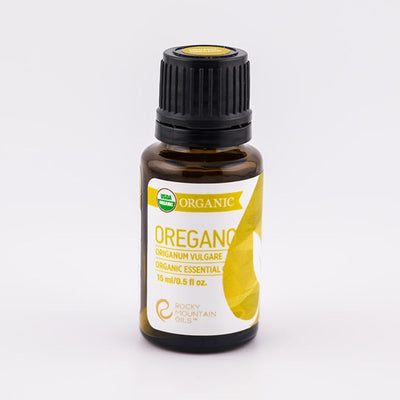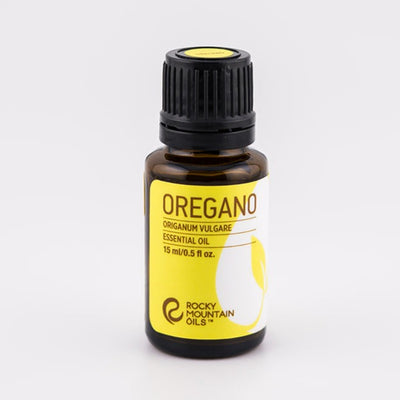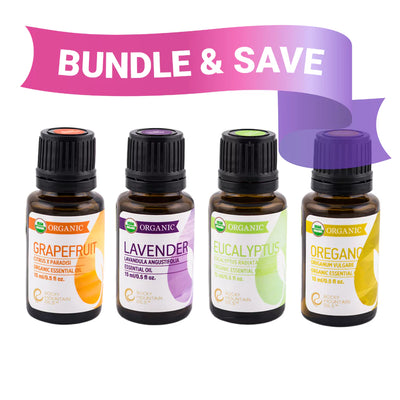How to Make Oregano Oil: Discover the Process in 6 Steps
Oregano oil is a powerhouse of wellness, revered for its antimicrobial and anti-inflammatory properties. Originating from the hills of the Mediterranean, this herbal oil has been a staple in natural medicine for centuries. In this article, we'll guide you through the traditional and modern methods of making your oregano oil, ensuring a product rich in health benefits and flavor.
How to Make Oregano Oil
Creating oregano oil at home begins with two essential components: fresh oregano leaves and carrier oil. We recommend olive or coconut oil for their health benefits and stability. The equipment required is minimal, ensuring this can be a simple and rewarding DIY project.

Brief Overview of Oregano Oil
Oregano oil is a natural extract from the oregano plant, primarily known for its potent antimicrobial properties. This essential oil is extracted through the process of steam distillation or cold-pressing fresh oregano leaves, concentrating the plant's active compounds. Oregano oil is rich in phenols, especially carvacrol and thymol, which contribute to its strong antibacterial, antiviral, and antifungal effects. Its spicy, herbaceous fragrance is distinctive and has been used historically in various cultural medicinal practices.
Benefits and Uses
Oregano oil offers a wide range of health benefits due to its potent properties. Here are some notable uses:
- Antimicrobial Effects: It can help fight off bacteria, viruses, and fungi, making it a popular choice for natural remedies against infections.
- Respiratory Health: Inhalation or consumption can alleviate symptoms of respiratory conditions such as coughs and colds.
- Digestive Aid: It aids in digestion and can help relieve upset stomachs.
- Anti-inflammatory: Its anti-inflammatory properties make it beneficial for reducing pain and swelling.
- Immune Booster: Regular use can strengthen the immune system.
- Skin Care: Applied topically, it can treat skin infections and irritations when diluted with a carrier oil.
Step-by-Step Process
Materials and Ingredients
- Fresh Oregano Leaves: Fresh leaves are the primary ingredient, and they are preferred for their high concentration of active compounds.
- Carrier Oil: Olive oil, coconut oil, or almond oil are commonly used to dilute oregano oil, making it safe for topical application and internal use.
- Mortar and Pestle or Blender: These tools are used to crush or blend the oregano leaves, facilitating the release of essential oils.
- Glass Jar with Lid: A clean, dry jar is needed to mix and store the oregano leaves and carrier oil.
- Cheesecloth or Fine Mesh Strainer: This is used to strain the oil after infusion, separating the plant material from the liquid.
- Dark Glass Dropper Bottles for Storage: Protects the oregano oil from light, preserving its potency.
Preparation
- Harvesting fresh oregano leaves straight from the plant allows you to enjoy their peak flavor and aroma as they retain their essential oils and nutrients. Opting for vibrant, green leaves ensures optimal freshness and potency, enhancing the culinary experience with their robust taste and fragrance.
- Thoroughly washing the leaves under running water is essential as it helps to eliminate any dirt or insects that may be clinging to the surface. Once washed, patting the leaves dry with a clean cloth or paper towel effectively removes excess moisture, ensuring they are clean and ready for consumption or use in recipes.
- When leaves are crushed with a mortar and pestle or blended, they are broken down into smaller pieces, which exposes more surface area. This increased surface area allows the oil to extract the active compounds present in the leaves more effectively.
- The ratio of oregano leaves to carrier oil, often set at 1:2, is a critical factor influencing both the efficacy and safety of the resultant product. However, variations in this ratio are permissible depending on individual preferences and intended use cases, allowing for customization while still maintaining desired therapeutic benefits.
- Crushing or chopping the leaves enhances their surface area, facilitating better extraction of their aromatic compounds when combined with the carrier oil. Placing them in a glass jar allows for a controlled environment where the infusion process can occur, ensuring maximum flavor and scent transfer into the oil.
Extraction Process
- Ensuring the complete submersion of the leaves in the carrier oil is vital during the extraction process as it facilitates the thorough infusion of the oil with the desired properties from the leaves. This method maximizes the extraction efficiency, ensuring that the resulting product possesses the full spectrum of beneficial compounds from the leaves.
- Stirring the mixture ensures that the oregano particles are dispersed uniformly within the oil, enhancing the extraction process and allowing for a homogeneous infusion. This even distribution of oregano throughout the oil results in a consistent flavor profile, enriching the final product with aromatic and savory notes.
- Sealing the jar effectively creates a barrier against external contaminants, safeguarding the integrity of the oil infusion process by preventing foreign particles from entering. Additionally, the sealed environment helps retain the volatile compounds within the mixture, ensuring that the infused oil maintains its desired flavor, aroma, and therapeutic properties over time.
Infusion
- Placing the jar in a spot with abundant sunlight and warmth is crucial for optimizing the infusion process, as it encourages the plant's oils to blend effectively with the carrier oil. This environment promotes the efficient release of aromatic compounds from the plant material, enhancing the overall infusion quality and potency.
- Shaking the jar daily facilitates an even distribution of oil over the oregano leaves, ensuring thorough coverage and strengthening the extraction process of active ingredients. This consistent agitation promotes the efficient infusion of the oil with the oregano, maximizing the release and absorption of beneficial compounds for optimal flavor and potency.
Straining
- The straining process plays a pivotal role in eliminating any residual plant matter from the oil, thereby guaranteeing the purity and cleanliness of the final product. Through meticulous training, any remaining particles or debris are filtered out, resulting in a high-quality oil free from impurities.
- When the plant material is compressed during the straining process, it effectively squeezes out any remaining oils or extracts, thereby maximizing the yield of infused oil. This ensures that all the beneficial compounds present in the plant material are fully extracted and utilized, minimizing waste and optimizing the potency of the infused oil.
- Proper disposal of leftover oregano leaves is crucial not only to reduce waste but also to uphold hygiene standards in the kitchen. By ensuring the correct disposal, such as composting or discarding in designated organic waste bins, you contribute to eco-friendly practices and prevent potential odors or contamination in your cooking area.
Storage
- Dark glass bottles are crucial for maintaining the integrity of oregano oil by shielding it from light exposure, which has the potential to diminish its efficacy over time. The opaque nature of these bottles acts as a barrier, safeguarding the delicate compounds within the oil and ensuring its potency remains intact for extended periods.
- Proper labeling is essential for ensuring the safe and effective utilization of oils, mainly when they are intended for therapeutic applications. Precise and accurate labeling provides users with necessary information regarding dosage, potential side effects, and proper usage instructions, thereby minimizing risks and promoting informed decision-making.
- Storing bottles of oregano oil in a relaxed, dark environment helps to preserve its potency and extend its shelf life by preventing exposure to light and heat, which can degrade its active compounds. This optimal storage condition safeguards the efficacy of the oil, ensuring it retains its therapeutic benefits for a longer duration.

Safety Precautions and Tips
When making oregano oil at home, it's crucial to handle essential oils with care due to their potency and concentrated nature. Always use high-quality, pure oregano leaves and carrier oil such as olive or coconut oil for dilution. Ensure proper ventilation in your workspace to prevent inhaling the strong vapors, and wear gloves to protect your skin from potential irritation. Lastly, store the finished oil in a dark glass bottle in a cool, dry place to maintain its potency and quality over time.
Quality Control
To assess the potency and purity of homemade oregano oil, start by examining its color and consistency; high-quality oregano oil tends to be dark greenish-yellow and has a slightly thick texture. Next, perform a smell test—pure oregano oil should have a strong, herbal aroma indicative of its potent compounds. Additionally, you can conduct a solubility test by mixing a drop of the oil in a small amount of water; if it disperses evenly without leaving an oily film, it suggests purity.
Lastly, consider investing in a refractometer to measure the oil's refractive index, which can help determine its concentration of active ingredients like carvacrol, the compound responsible for its therapeutic properties. By employing these methods, you can ensure the oregano oil you produce at home is both potent and pure, maximizing its effectiveness and safety for various uses.
Application and Usage
Oregano oil is renowned for its potent antimicrobial properties, making it a popular choice for treating respiratory infections such as colds and sinusitis. Additionally, its rich flavor and aroma make it a versatile ingredient in culinary endeavors, adding depth and complexity to dishes ranging from pasta sauces to salad dressings. Incorporating oregano oil into your daily routine can provide both health benefits and culinary delight, making it a valuable addition to any home pantry or natural medicine cabinet.
Enhancing the Potency of Oregano Oil
To maximize the effectiveness of homemade oil while ensuring safety, consider using high-quality, organic ingredients known for their therapeutic properties. Experiment with different ratios and combinations of herbs, flowers, and essential oils to enhance the potency of your blend. Additionally, employ proper sterilization techniques and storage practices to prevent contamination and preserve the oil's integrity for prolonged use.

How do you get oil of oregano?
Oil of oregano is typically obtained through a process called steam distillation, where fresh or dried oregano leaves are subjected to steam, causing the essential oil to be released from the plant material. The steam containing the oil is then condensed and collected, and the oil is separated from the water. Another method involves macerating oregano leaves in a carrier oil, such as olive oil, and letting it sit for a period of time to infuse the oil with the oregano's properties.
What are the main ingredients in oregano oil?
The main ingredients in oregano oil are carvacrol, thymol, terpinene, caryophyllene, and rosmarinic acid. Carvacrol and thymol are the primary active compounds responsible for the antimicrobial properties of oregano oil, while terpinene contributes to its antioxidant effects. Caryophyllene provides anti-inflammatory properties, and rosmarinic acid has antioxidant and antimicrobial properties as well. These compounds work together to give oregano oil its potential health benefits, including its use as a natural remedy for various ailments such as respiratory infections, digestive issues, and skin conditions.
Is homemade oregano oil safe?
Homemade oregano oil can be safe if prepared and used properly. However, it's important to note that essential oils, including oregano oil, are highly concentrated and can be irritating or even toxic if not diluted correctly or used in excessive amounts. Additionally, there may be variations in potency and purity depending on how the oil is made. It's advisable to do thorough research, use quality ingredients, and consult with a healthcare professional before using homemade oregano oil for medicinal purposes.
Frequently Asked Questions
How often can I apply oregano oil topically?
Oregano oil should be applied sparingly; generally, 2-3 times a day is sufficient. Always dilute it with a carrier oil to prevent skin irritation.
Can oregano oil interact with medications?
Yes, oregano oil can interact with certain medications, particularly blood thinners and diabetic medication. Consult your healthcare provider before using.
Is oregano oil safe for pregnant or nursing women?
Pregnant or nursing women should avoid using oregano oil as it can affect the body in ways that may not be safe during these periods. Always seek medical advice first.
Can I make oregano oil without carrier oil?
Technically, yes, but it's not recommended. Without a carrier oil, the essential oil would be too strong and could cause irritation or adverse reactions.
How long does it take to make homemade oregano oil?
The process can take anywhere from a few days to a few weeks, depending on the method used. The infusion method is typically quicker than distillation.
Can children use oregano oil?
Children under the age of six should generally not use oregano oil. For older children, use significantly diluted concentrations and consult a healthcare professional first.
Conclusion
In wrapping up, making your oregano oil can be a fulfilling and practical endeavor, offering a natural solution for various health issues and culinary needs. By following the steps outlined, employing safety measures, and understanding its uses and limitations, you can harness the power of oregano oil safely and effectively. Whether you're looking to boost your health, add zest to your meals, or seek natural remedies, homemade oregano oil is a versatile addition to your wellness and culinary arsenal. Start your oregano oil journey today and unlock the natural benefits of this ancient herbal remedy.




